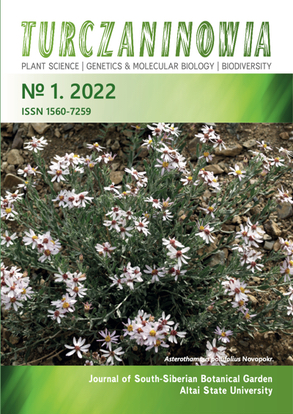Candelariella xanthostigmoides (Candelariaceae, Ascomycota) – a new lichen record to East Asia from Japan
Abstract
Candelariella xanthostigmoides is newly reported from East Asia. It was collected on bark of Tsuga diversifolia in Honshu (Japan) at elevations between 900 and 1100 m. Characteristic features of the species, distribution and the comparison with the closest species are given.
Downloads
Metrics
References
Aptroot A., Moon K. H. 2014. 114 new reports of microlichens from Korea, including the description of five new species, show that the microlichen flora is predominantly Eurasian. Herzogia 27(2): 347–365. DOI: 10.13158/heia.27.2.2014.347
Aptroot A., Sparrius L. B. 2003. New microlichens from Taiwan. Fungal Diversity 14(1): 1–50.
Arup U., Ekman S. 1992. Nyheter i södra Sveriges lavflora. Graphis Scripta 4(2): 81–86.
Bomble F. W. 2015. Die epiphytischen Candelariella-Arten im Aachener Stadtgebiet und Umgebung. Veröff. Bochumer Bot. Ver. 7(1): 1–10.
Culberson C. F., Johnson A. 1982. Substitution of methyl tert-butyl ether for diethyl ether in the standardized thin-layer chromatographic method for lichen products. Journal of Chromatography 238(2): 483–487.
Culberson C. F., Kristinsson H. D. 1970. A standardized method for the identification of lichen products. Journal of Chromatography 46(1): 85–93.
Filson R. B. 1992. Candelariaceae. In: Flora of Australia. Vol. 54. Canberra: Australian Government Publishing Service. Pp. 97–101.
Hauck M., Tønsberg T., Mayrhofer H., de Bruyn U., Enkhtuya O., Javkhlan S. 2013. New records of lichen species from western Mongolia. Folia Cryptogamica Estonica 50: 13–22. DOI: 10.12697/fce.2013.50.03
Исмаилов А. Б., Урбанавичюс Г. П., Яковченко Л. С., Урбанавичене И. Н. Род Candelariella (Candelariaceae, Candelariales) в лихенофлоре Кавказа // Бот. журн., 2017. Т. 102, № 6. С. 780–796.
Jacobsen P. 1989. Additions and corrections to the lichen checklist of Schleswig-Holstein (N Germany). Graphis Scripta 2(3): 83–85.
Khodosovtsev A., Darmostuk V. 2020. Records of lichen species new for Ukraine from steppe habitats of the country. Botanica Serbica 44(2): 243–250. DOI: 10.2298/BOTSERB2002243K
Kondratyuk S. Y., Lőkös L., Halda J. P., Farkas E., Upreti D. K., Thell A., Woo J.-J., Oh S.-O., Hur J.-S. 2018. New and noteworthy lichen-forming and lichenicolous Fungi 7. Acta Botanica Hungarica 60(1–2): 115–184. DOI: 10.1556/034.60.2018.1-2.8
Kondratyuk S., Lőkös L., Tschabanenko S., Haji-Moniri M., Farkas E., Wang X., Oh S.-O., Hur J.-S. 2013. New and noteworthy lichen-forming and lichenicolous fungi. Acta Botanica Hungarica 55(3–4): 275–349. DOI: 10.1556/ABot.55.2013.3-4.9
Kubiak D., Westberg M. 2011. First records of Candelariella efflorescens (lichenized Ascomycota) in Poland. Polish Botanical Journal 56(2): 315–319.
Kurokawa S., Kashiwadani H. 2006. Checklist of japanese lichens and allied fungi. National Science Museum Monographs 33: 1–157.
Lendemer J. C., Westberg M. 2010. Candelariella xanthostigmoides in North America. Opuscula Philolichenum 8: 75–81.
Liu D., Wang L., Wang X. Y., Hur J.-S. 2019. Two new species of the genus Candelariella from China and Korea. Mycobiology 47(1): 40–49. DOI: 10.1080/12298093.2019.1583785
Müller J. 1882. Lichenologische Beiträge XVI. Flora 65: 483–490.
Ohmura Y., Kashiwadani H. 2018. Checklist of lichens and allied fungi of Japan. National Museum of Nature and Science Monographs 49: 1–140.
Otte V. 2005. Noteworthy lichen records for Bulgaria. Abhandlungen und Berichte des Naturkundemuseums Görlitz 77(1): 77–86.
Rohrer A., Bilovitz P. O., Mayrhofer H. 2012. Lichenized fungi from the Jakupica mountain range Macedonia, FYROM. Herzogia 25(2): 167–175. DOI: 10.13158/heia.25.2.2010.165
Sliwa L., Kukwa M. 2012. New distribution data for sterile crustose lichens in the Polish Tatra Mts and its surroundings. Polish Botanical Journal 57(1): 259–278.
Thor G., Søchting U. 2018. New or interesting lichenized and lichenicolous fungi from Denmark. Graphis Scripta 30(6): 138–148.
Урбанавичене И. Н., Урбанавичюс Г. П. К лихенофлоре Северо-Осетинского заповедника (Северная Осетия – Алания). I. Кластер «Шуби» // Новости сист. низш. раст., 2019. Т. 53, № 2. С. 349–368. DOI: 10.31111/nsnr/2019.53.2.349
Westberg M. 2007. Candelariella (Candelariaceae) in western United States and northern Mexico: the polysporous species. The Bryologist 110(3): 375–390. DOI: 10.1639/0007-2745(2007)110[375:CCIWUS]2.0.CO;2
Westberg M., Clerc P. 2012. Five secies of Candelaria and Candelariella (Ascomycota, Candelariales) new to Switzerland. Mycokeys 3: 1–12. DOI: 10.3897/mycokeys.3.2864
Westberg M., Sohrabi M. 2012. A conspectus of the lichen genus Candelariella (Candelariaceae, Ascomycota) in Southwest Asia with emphasis on Iran. Nova Hedwigia 95(3–4): 531–546. DOI: 10.1127/0029-5035/2012/0060
Turczaninowia is a golden publisher, as we allow self-archiving, but most importantly we are fully transparent about your rights.
Authors may present and discuss their findings ahead of publication: at biological or scientific conferences, on preprint servers, in public databases, and in blogs, wikis, tweets, and other informal communication channels.
Turczaninowia allows authors to deposit manuscripts (currently under review or those for intended submission to Turczaninowia) in non-commercial, pre-print servers such as ArXiv.
Authors who publish with this journal agree to the following terms:
- Authors retain copyright and grant the journal right of first publication with the work simultaneously licensed under a Creative Commons Attribution License that allows others to share the work with an acknowledgement of the work's authorship and initial publication in this journal.
- Authors are able to enter into separate, additional contractual arrangements for the non-exclusive distribution of the journal's published version of the work (e.g., post it to an institutional repository or publish it in a book), with an acknowledgement of its initial publication in this journal.
- Authors are permitted and encouraged to post their work online (e.g., in institutional repositories or on their website) prior to and during the submission process, as it can lead to productive exchanges, as well as earlier and greater citation of published work (See The Effect of Open Access).





